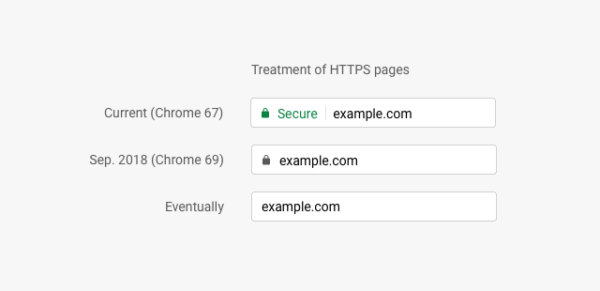Since Google reported that it will check all HTTP pages over the web as “not secure,” it frightened away site proprietors with completely unsafe pages thinking about its effect to traffic and webpage performance, and thus, a substantial number of website pages have begun to be relocated to HTTPS to satisfy the search giant, whose Chrome browser is utilized by in excess of 50 percent of the web population. In perspective of that reality, Google has officially proclaimed that it will soon be bringing down the “secure” label on all HTTPS pages, and greater security changes in Chrome can be expected post this year.

The product supervisor for Chrome Security at Google, says they will expel Chrome’s sure security pointers over the long haul so a site’s default security status is secure and clients “will be cautioned when there’s an issue.” The procedure will start in September with the end of the “secure” identification in Chrome 69 version that is yet a more unbending measure will be put on the ground in the next month in Chrome 70, which is the position of the red “not secure” warning when users give out delicate information on all HTTP pages. She takes note of that the use of HTTP sites was “too high” to check all pages with a solid red warning appropriate next to the address bar, however the tide has changed since its unabated alerts over the most recent couple of months. As beforehand declared, Google will begin denoting all HTTP sites as “not secure” in July. Schechter underscores the significance of a protected web which she says is apparently sheltered as a matter of course thus she supports that pages be moved to HTTPS.
Also Read: Start Using These 4 Tools To Increase Ranking Of Your YouTube Videos
Google has been reviving for HTTPS, a more secure version of the HTTP protocol utilized on the web for clients to interface with websites. Its first exceptional move concerning this was in January 2017 with the arrival of Chrome 56, labeling HTTP pages that gather charge cards or passwords as “not secure”. This was followed in October 2017 with the arrival of Chrome 62, marking HTTP locales saw in Incognito mode as “not secure”. And, if you want to know more about this then you can gather many useful information because Google understands everything about you.
Well done to Google for declaring the demise of HTTP, which faces certain eradication for each site this side of the long tail. It’s a far cry from the astounding wordiness of the past. Take Internet Explorer 8 (2009-11), which used to hurl the accompanying dialogue when going to a website utilizing HTTPS:
Also Read: Strategies To Get High-Quality Backlinks Which Works in 2018
Henceforth, if you find this blog informative and helpful then in that situation you can share this blog on all the social media platforms like Twitter, Facebook, Pinterest, and so on.